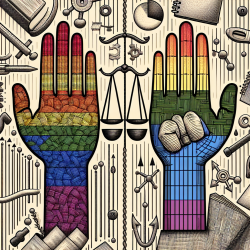Introduction
The prevalence of poverty among LGBTQ2S+ communities in Canada is increasingly recognized as a critical area for social work intervention. A recent study, "Poverty in Lesbian, Gay, Bisexual, Transgender, Queer, Two-Spirit, and Other Sexual and Gender Minority (LGBTQ2S+) Communities in Canada: Implications for Social Work Practice," highlights the urgent need for targeted social work strategies to address these disparities. This blog explores the findings of this study and offers insights into how practitioners can implement these outcomes to enhance their practice.
Understanding LGBTQ2S+ Poverty
The study reveals that LGBTQ2S+ individuals face distinct expressions of poverty, which are influenced by factors such as age, race, newcomer status, and Indigeneity. These groups experience systemic inequities in income, housing, and employment, which are often exacerbated by discrimination and stigma. The myth of "gay affluence" further obscures these issues, leading to a lack of targeted interventions within the social work field.
Intersectionality and Relational Poverty Analysis
The research employs intersectionality and relational poverty analysis as frameworks to understand and address these material inequities. Intersectionality allows for the examination of how overlapping identities impact the experiences of poverty, while relational poverty analysis focuses on the power dynamics that sustain these conditions. Together, these frameworks provide a comprehensive approach to conceptualizing social work interventions.
Implications for Social Work Practice
Social workers can utilize these insights to inform their practice at various levels:
- Micro-Level Interventions: Practitioners should challenge the myth of "gay affluence" by recognizing the diverse needs of LGBTQ2S+ clients. This includes advocating for resources related to housing, employment, and education while providing clinical support.
- Meso-Level Interventions: At the organizational level, social workers can advocate for policies that prioritize LGBTQ2S+ clients, such as developing specialized programs for homeless LGBTQ2S+ youth.
- Macro-Level Interventions: Social workers can engage in research and advocacy to highlight the systemic nature of LGBTQ2S+ poverty, partnering with community stakeholders to amplify their voices in policy development.
Conclusion
Addressing LGBTQ2S+ poverty requires a multifaceted approach that integrates intersectionality and relational poverty analysis into social work practice. By doing so, practitioners can better address the unique challenges faced by these communities and promote social justice. To read the original research paper, please follow this link: Poverty in Lesbian, Gay, Bisexual, Transgender, Queer, Two-Spirit, and Other Sexual and Gender Minority (LGBTQ2S+) Communities in Canada: Implications for Social Work Practice.










